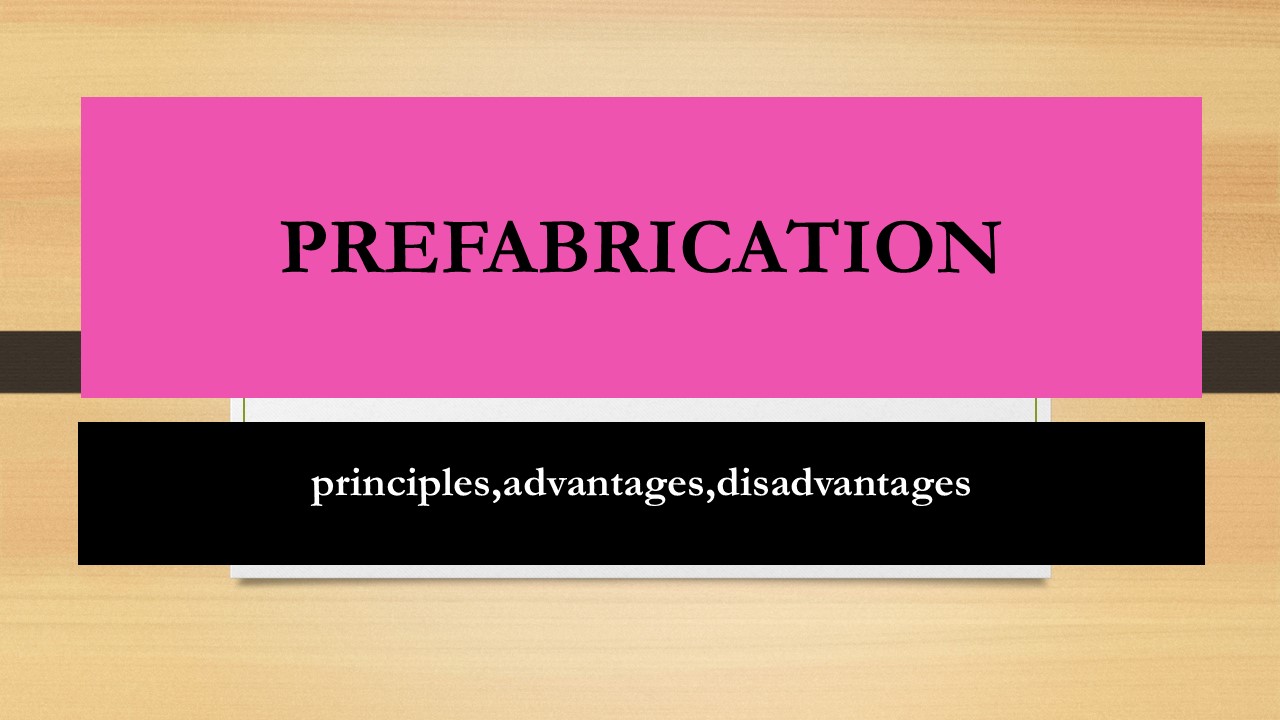Pre-fabrication
Pre-fabrication is the practice of assembling the components of a building other than the building sites, i.e., in the factory or a manufacturing site, and transporting either complete assemble or semi-assembled to the construction site where the structure is located.
This method controls the construction cost by economizing the wages, time, and materials.
The pre-fabrication is done in two stages
- Manufacturing under factory conditions
- Erection of structures at locations
Broadly stages are classified as:
- Casting
- Curing
- Transportation and erecting
Advantages:
- The need for formwork, scaffolding & shuttering is reduced.
- Construction time is reduced.
- Quality control is easier in a factory than on a construction site.
- Congestion in the site is minimized.
- Time spent due to bad weather at the construction site is minimized.
- Less wastage.
Disadvantages:
- Great attention is required while joining the pre-fabricated section to avoid joint failure.
- Leakage from the joint is possible if not properly jointed.
- High transportation cost is required for the transportation of bulky & voluminous sections.
- If the prefabricated section is heavy then a crane is required at the site.
- Local jobs are lost
- Can’t hide cable wiring, it can be expensive.
Commonly used pre-fab material in Nepal:
Fiber cement Board:
- These are the sandwich panel of two fiber-reinforced cement sheets enclosing a lightweight core composed of Portland cement, binder, and aggregate.
- The panel has a tongue & groove joining system that facilitates rapid construction with minimum effort.
- The board has a low water absorption rate.
- Thickness 50 to 75 mm, width 2’ & height varies from 8’ to 10’.
PUF Panel
- PUF panel consists of the prefabricated sandwich panel made of GI sheet and polyurethane between them.
- The PUF panel are interlocked with each other by a cam lock system or through a tongue & groove arrangement.
- PUF is generally used for roofs & it is the newest type of roofing panel.
- It has a beautiful appearance.
- PUF panel are available in standard width of 1 m and various thickness 50,60,80,120,150 & 200 mm.
Rockwool Panel
- Rockwool panel consists of a prefabricated sandwich panel of GI sheet on both sides.
- Insulation against sound in this type of panel is remarkable.
- They are used in wall.
EPS Panel
- EPS panel is made by using thermocol/expanded polystyrene covered by a metal sheet on both sides.
- Expanded polystyrene (EPS) is a lightweight cellular paper material consisting of a small hollow spherical ball.
- EPS panel requires light installation & has a short construction period.
- It is low cost, can bear a high load, is moisture-proof, sound-insulating & heat insulating.
Visually there are not a lot of differences between a prefab house and a house made of bricks & stones. pre-fab buildings look the same as any ordinary houses.
Prefab houses are comfortable, portable, and durable in the long run.
The beauty of prefab houses is that they take far less time to build than concrete houses. The prefab materials required to build the house are manufactured at the factory and then assembled at the site.
- The material used to construct walls in a prefab house are lighter than bricks.so, living in an earthquake-prone zone with fears of our own house crumbling down on us, a prefab house should do little damage.
- People have this misconception that prefab houses are only temporary when actually the prefab house is an excellent permanent alternative to the traditional house we have.
- Prefab houses are also certified fireproofs, waterproofs, weatherproofs & earthquake resistant.
The drawbacks: –
- once the house is installed it can’t be painted over or plastered with the wallpaper of your choice.
- Also, because it’s a thin wall, the wiring inside the house can’t be hidden.
- Another drawback of a prefab house is the money factor, it can be fairly expensive, and a lot of materials have to be imported thus resulting in a high price.
- With prefab s house with 3- bedroom, total 5 room can take one to the half-month of construction.
- The initial construction phase is similar to that of a concrete house, it has a foundation & strong steel structure, the only difference is instead of bricks prefabs are installed in the wall.
- Price per square foot is from Rs 2000 to 3500.
Advantages:
- Safe
- Earthquake proof
- Fire proof
- Weather proof
- Quick assembly
- Durable & potable
- Short construction period

